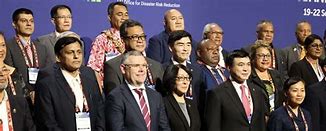Context:
Recently, the Union Minister of State for Home Affairs participated in the Asia-Pacific Ministerial Conference on Disaster Risk Reduction (APMCDRR) 2024 in Manila, Philippines.
Asia-Pacific Ministerial Conference on Disaster Risk Reduction (APMCDRR)
- APMCDRR is the main platform in Asia and the Pacific to monitor, review, and enhance cooperation for the implementation of the Sendai Framework for Disaster Risk Reduction 2015-2030 at the regional level.
- Host of APMCDRR 2024: The Government of the Philippines in partnership with the United Nations Office for Disaster Risk Reduction (UNDRR).
- APMCDRR organised from 14 to 18 October 2024 at the Philippine International Convention Center in Manila.
- APMCDRR 2024 working theme: “Surge to 2030: Enhancing ambition in Asia-Pacific to accelerate disaster risk reduction”.

Highlights of the Conference
- The adoption of the 2024-27 Asia Pacific Action Plan for the Implementation of the Sendai Framework
- The call to establish an Intergovernmental Alliance on Anticipatory Action
- A reinvigorated commitment to endorse and implement the Comprehensive School Safety Framework 2022-2030
- The rollout of the Gender Action Plan for the Implementation of the Sendai Framework
- The ongoing development of Call to Action to Build Back Better by investing in Recovery Readiness
- The 1st Intercessional Meeting of Disaster Risk Management Ministers of the Pacific
Sendai Framework for Disaster Risk Reduction 2015-2030
- The Sendai Framework for Disaster Risk Reduction 2015-2030 was adopted at the Third UN World Conference in Sendai, Japan, on March 18, 2015.
- It was the first major agreement of the post-2015 development agenda and provides Member States with concrete actions to protect development gains from the risk of disaster.
- The Sendai Framework is the successor instrument to the Hyogo Framework for Action (HFA) 2005-2015: Building the Resilience of Nations and Communities to Disasters.
- The World Conference on Disaster Reduction was held in 2005 in Kobe, Hyogo, Japan, and adopted the Hyogo Framework.
- The Sendai Framework outlines seven global targets and four priorities to be achieved between 2015 and 2030.
7 Targets of Sendai Framework
- Substantially reduce global disaster mortality by 2030, aiming to lower the average per 100,000 global mortality between 2020-2030 compared to 2005- 2015.
- Substantially reduce the number of affected people globally by 2030, aiming to lower the average global figure per 100,000 between 2020-2030 compared to 2005- 2015.
- Reduce direct disaster economic loss in relation to global gross domestic product (GDP) by 2030.
- Substantially reduce disaster damage to critical infrastructure and disruption of basic services, among them health and educational facilities, including through developing their resilience by 2030.
- Substantially increase the number of countries with national and local disaster risk reduction strategies by 2020.
- Substantially enhance international cooperation to developing countries through adequate and sustainable support to complement their national actions for implementation of this framework by 2030.
- Substantially increase the availability of and access to Mult hazard early warning systems and disaster risk information and assessments to people by 2030.
India’s Initiative for Disaster Risk Reduction
PM’s 10-point agenda for Disaster Risk Reduction (DRR) strategies: The Indian PM enunciated a Ten-Point Agenda in his inaugural speech at the Asian Ministerial Conference on Disaster Risk Reduction (AMCDRR) 2016, held in New Delhi. The ten key elements consist of the following:
1. Mainstreaming Disaster Risk Reduction in Public Expenditure, particularly in infrastructure development
2. Risk Coverage for All, particularly for the poorest
3. Greater involvement and leadership of Women in Disaster Risk Management
4. Invest in Mapping Disaster Risk, covering all hazards
5. Leverage technology to enhance the efficiency of disaster risk management efforts
6. Develop a network of Universities to work on disaster issues
7. Make use of social media and Mobile Technologies for disaster risk reduction
8. Invest in local capacity, not only for response but also for disaster risk reduction
9. Systematize Post-Disaster Recovery based on lessons learned from past disasters
10. Bring about greater cohesion in international response to disasters
Indian Tsunami Early Warning Centre (ITEWC): It is established at the Indian National Centre for Ocean Information Sciences, (INCOIS), Hyderabad, under the Ministry of Earth Sciences. It is the national authority to issue tsunami advisories for India.
- Established in response to the 2004 Tsunami, it also provides Tsunami advisories to 25 Indian Ocean countries as part of the Intergovernmental Oceanographic Commission (IOC) of UNESCO.
Coalition for Disaster Resilient Infrastructure (CDRI): It is a global partnership of governments, UN agencies, development banks, the private sector, and knowledge institutions focused on enhancing the resilience of infrastructure systems to climate and disaster risks, supporting sustainable development.
- The headquarters of the CDRI Secretariat is in New Delhi, India.
Dedicated financial provisions for DRR: The 15th Finance Commission of India has allocated USD 30 billion for the National Disaster Risk Management Fund (NDRMF) and State Disaster Risk Management Fund (SDRMF) for the financial cycle 2021-22 to 2025-26.

